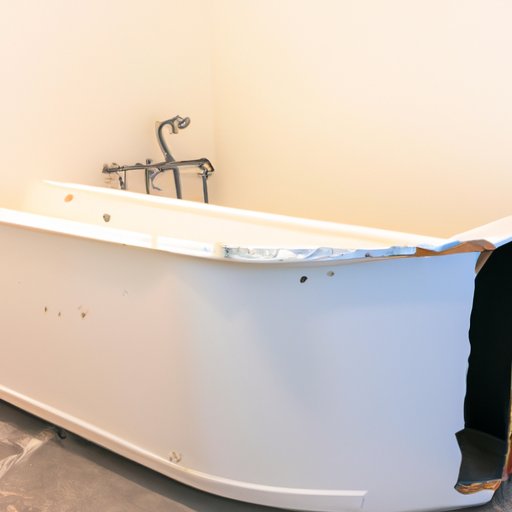
Introduction
Removing a bathtub can seem like a daunting task, but with the right tools and knowledge, it can be a DIY project that you can tackle on your own. If you are remodeling your bathroom or simply want to replace your old bathtub, removing it is the first step. In this article, we’ll provide you with a step-by-step guide on how to remove a bathtub, including helpful tips and tricks to make the job easier.
Step-by-Step Guide
Before you start, make sure you have all the necessary tools, including safety goggles and gloves, a reciprocating saw, a utility knife, a pry bar, a hammer, and a wrench. Here is a step-by-step guide:
- Turn off the water supply – Before starting to remove a bathtub, make sure that the water supply is turned off. Turn off the main water supply and then switch off the water valve near the bathtub.
- Remove the bathtub drain – Unscrew the drain stopper and remove it. Then use pliers to remove the drain flange and expose the drainpipe.
- Disconnect the bathtub water supply – Use a wrench to disconnect the pipes that bring water into the bathtub. Make sure to place a container to catch any water that may spill out when the pipes are disconnected.
- Remove the bathtub faucet – Remove the screws that hold the faucet in place and gently lift it out of the way. Be careful not to damage any of the surrounding plumbing.
- Detach the overflow cover – Remove the screws that hold the overflow cover in place and take it out.
- Cut the caulk and remove the tub – Use a utility knife to cut the caulk along the edges of the bathtub. Then use a pry bar to gently lift the tub away from the wall.
- Cut the tub into pieces – If the bathtub is too large to remove in one piece, cut it into manageable pieces using a reciprocating saw.
- Remove the tub – Once the bathtub is in pieces or fully removed, dispose of it properly.
Video Tutorial
For a more visual and interactive demonstration of the process, watch our video tutorial:
If you prefer to read the steps, check out the written guide above.
Frequently Asked Questions
Here are some commonly asked questions about removing a bathtub:
- What tools do I need to remove a bathtub?
You will need safety goggles and gloves, a reciprocating saw, a utility knife, a pry bar, a hammer, and a wrench. - How long does it typically take to remove a bathtub?
Removing a bathtub can take anywhere from one to two hours, depending on the size of the bathtub and the amount of caulk and adhesive holding it in place. - What do I do with the old bathtub once I remove it?
Check your local waste disposal regulations for proper disposal or recycling options. Some cities offer bulk item pick-up or recycling programs for bathtubs.
Tips and Tricks
Here are some tips and tricks to make the process of removing a bathtub easier:
- Protect surrounding walls and fixtures – Cover nearby fixtures and walls with cardboard or drop cloths to protect them from damage.
- Remove stubborn caulk or adhesive – Use a heat gun or a hairdryer to soften the caulk or adhesive, making it easier to remove.
- Have a helper – Removing a heavy bathtub can be a two-person job. Have someone on hand to help you lift and move the tub.
- Use caution – Make sure to wear protective gear, and use caution when removing a bathtub to avoid injury or damage to surrounding materials.
Pros and Cons
Removing a bathtub has both pros and cons:
- Pros: Removing a bathtub can create more space and provide an updated look to your bathroom. It’s also easier to clean the space where the tub used to be.
- Cons: Removing a bathtub can be expensive if you’re hiring a professional, and it can be a time-consuming process if you’re doing it yourself. Removing a bathtub can also decrease the resale value of your home if you don’t replace it with another bathtub.
Conclusion
Removing a bathtub can be a challenging task, but with the right tools and knowledge, you can do it yourself. The step-by-step guide, video tutorial, frequently asked questions, tips and tricks, and pros and cons should give you the confidence to take on the project. Just make sure to take safety precautions and use caution throughout the process.




